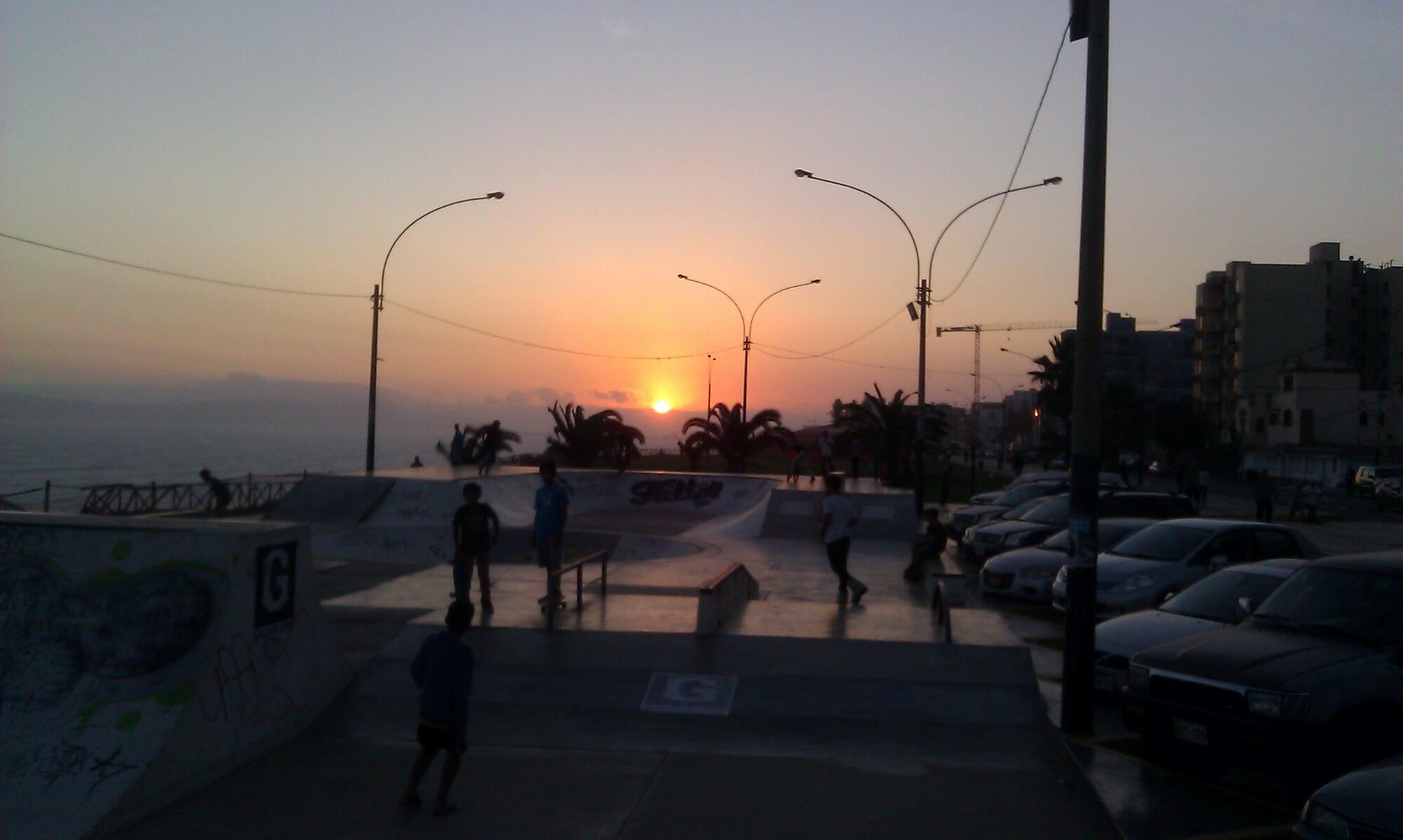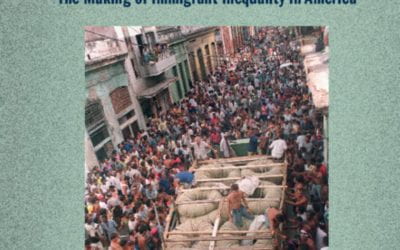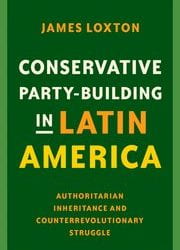A Letter from Peru
A Mixture of Pandemics

It was the end of summer in the Southern Hemisphere. My wife Gisela and I had planned to combine preparing for the new academic year with trips to the beach, enjoyment of the cultural night life of Lima and just getting together with friends. Unexpectedly, the distant news of an epidemic—accompanied by rumors of quarantines and curfews—reached us; followed soon enough by the decree of a State of Sanitary Emergency throughout Peru. The start of the new academic year at universities and schools was postponed; and, a few days later, on March 15, a national quarantine was decreed for the first time in our history. The Peruvian government postponed the end of the quarantine many times before its definitive ending date on June 30.
The promise that each day would be better than the previous one faded for most of Lima’s nine million inhabitants. The city, usually characterized by its noisy traffic and busy life, came to a standstill for the pandemic. Workers in the informal sector who depended on daily sub-wages to survive lost their essential means of income. Company employees in non-essential sectors were one step away from extreme poverty. Meanwhile, a minority had the opportunity to choose to spend quarantine in their beach or country homes. The social inequality gap became gigantic.
For more than a decade, we had celebrated the continuous growth of the Peruvian economy under the happy symbol of the new gastronomy, the phenomenon called “Mistura.” Our national socio-cultural diversity, which the indigenous writer José María Arguedas described as Todas las Sangres, or “every type of blood,” became the engine of our success. All we needed was to discover the needs of the market and have an entrepreneurial spirit. Under the “Mistura” emblem, politicians and corporations promoted entrepreneurship in schools and the media, while they limited investment in public health but facilitated concessions for extractive corporations in the Amazon forests and Andean mountains.
In late February, I had joked with my colleagues at the Pontifical Catholic University of Peru (PUCP) about the possibility of teaching courses over the Internet. The joke became true, and it stopped being funny. We had to transfer everything to virtual platforms and register with Zoom. We had no clear idea of how to distribute the syllabus between synchronous and asynchronous sessions—those in which students would be present and the ones they would be watching later. All that strange language is now common. Following three weeks of delayed opening, university classes for the first semester of 2020 started virtually. Having learned a new medium of teaching, instructors needed to dedicate the first week to guide students through the unknown. Most of my students were in Lima, a few in other Peruvian cities on the coast, the Andes, the Amazon, and one student was in Japan.

A national phenomenon emerged when immigrants to the city started to return to their original lands. The pandemic had thrust hundreds of thousands of people of all ages into the most vulnerable circumstances, unable to find food and shelter. They walked the empty roads and highways to return to their homes outside the city but also outside Peru. Among them, were immigrants from neighboring countries like Venezuela. People in the rural areas began to organize and help the migration. Various groups from the coast, the Andes and the Amazon sent trucks with food to their fellow residents, and also to those who were trapped in the cities. These organized groups offered food to the walkers. Other people also closed their doors, fearful of the virus. When national and regional authorities took notice, they began to quarantine the returnees in stadiums and in some cases helped them with transportation to their final destination.
A few weeks after classes started, one of my students informed me that she and her mother had contracted Covid-19 and that she would withdraw from the course. At that time, private health insurance did not cover the costs of Covid treatment—more than US$1,000 a day per person. I wished my student and her mother a speedy recovery, and asked her to keep me apprised of her situation. Public hospitals were overwhelmed with patients. For a while, hospitals had been chronically underfunded and undersourced. Thus, unfit to respond to the needs of the population.
Even under the best of circumstances, getting a medical appointment could take months, and getting an appointment for surgery could take years. The pandemic became a coup de grace for many health institutions. We witnessed friends, family and colleagues who lost loved ones. A few days after the quarantine ended, a colleague from my academic department died unexpectedly. Until June 30, the last day of the national quarantine, 285, 213 persons were infected with coronavirus and 9,677 died from it (the Peruvian population is almost 32 million people). The relatives of deceased were unable to say goodbye and mourn them according to their beliefs and cultural traditions. Incinerations and speedy burials were conducted in the most private manner available.
All universities have been affected by social distancing and recession. The university where I work reduced the tuition and fees costs of students whose parents lost their jobs, and cut the salaries of the authorities, administrative workers and professors. At the same time, it reduced funds for research. Despite everything, the university was able to continue with most of its courses, although many courses in Performing and Plastic Arts and science laboratories postponed their activities completely.
The government initially distributed subsidies of just over US$100 per family among Peruvians in poverty and extreme poverty to mitigate the food emergency that generated by the quarantine. The government then also experimented with three other means of payment to reach those who had been left out of the previous subsidies. Even so, aid never reach many rural citizens, a large percentage of whom are indigenous and people of African descent (located on the coast, the Amazon and the Andes). The Peruvian state has historically excluded these rural citizens from education and health services. At the same time, the government allocated an amount equivalent to 8% of the country’s GDP to loans with interest rates of 1.1% for private businesses. Loans for each of the large companies were almost three million dollars.

During these months, in addition, the brutal sexual violence that civil society and the State have sought to eradicate through different laws, programs and actions continued to operate. Government offices served more than four hundred underage women who had been raped, in addition to one hundred and forty adult women. They confirmed more than thirty femicides and received more than five hundred reports about women missing during the quarantine.
Throughout the confinement, without the smoke from factories and the pollution produced by heavy traffic, we discovered new colors in the skies of Lima and other industrial cities. Along the coastal shores of cities like Mollendo, sea lions and pelicans became customary visitors. Also various forms of solidarity emerged between neighbors, students, groups and towns. In my multi-family building, a woman posted a notice offering to buy food and medicine for elderly neighbors. Countless collectives communicated through cell phones collected money to help members with medicine, food, travel tickets or other needs.
In adversity, hope also flourished, and continues to do so. Peruvian poets, such as the indigenous César Vallejo and the Afro-descendant Nicomedes Santa Cruz, constantly dreamed and rediscovered the deep meaning of life through the solidarity of peoples in struggle:

Una carta desde Perú
Una mistura de pandemias
Por Luis Martín Valdiviezo Arista

Era el final del verano en el hemisferio Sur. Mi esposa Gisela y yo habíamos planeado intercalar nuestra preparación para el nuevo año académico con escapadas a la playa, la vida cultural nocturna de Lima y las reuniones habituales de amigos. Inesperadamente, las lejanas noticias de una epidemia—con rumores de ciudades en cuarentena y con toques de queda—atravesaron las fronteras y el gobierno peruano decretó el Estado de Emergencia Sanitaria en todo el país. Se pospuso el inicio de las clases universitarias y escolares, y, a los pocos días, el 15 de marzo, se decretó, por primera vez en nuestra historia, una cuarentena nacional. Después de sucesivas prórrogas, esta cuarentena duró hasta el 30 de junio.
Tan pronto el tráfago de la ciudad fue puesto en pausa por la pandemia, la promesa de que cada día sería mejor que el anterior se desvaneció para la mayoría de sus nueve millones de habitantes. Los trabajadores informales que dependían de sub-salarios diarios para sobrevivir, pasaron a la indigencia. Los trabajadores formales, en empresas de sectores no esenciales, quedaron a un paso de la pobreza extrema. Mientras tanto, una minoría escogió disfrutar de la cuarentena en sus casas de playa o de campo. Las brechas de desigualdad social se hicieron gigantes.
Por más de una década habíamos celebrado el crecimiento continuo de la economía peruana bajo el emblema feliz de la nueva gastronomía, el fenómeno de Mistura. El éxito podía nutrirse de nuestra diversidad socio-cultural nacional, que el escritor indígena José María Arguedas describió como “Todas las sangres”. Solo bastaba descubrir las necesidades del mercado y tener un espíritu emprendedor. Bajo el emblema de Mistura, los gobiernos últimos y las empresas propalaron el emprendurismo en las escuelas y los medios de comunicación, mientras redujeron las inversiones en la salud pública pero facilitaron las concesiones para las corporaciones extractivistas en los bosques amazónicos y las montañas andinas.
En los últimos días de febrero, yo había bromeado con mis colegas de la Pontificia Universidad Católica del Perú (PUCP) sobre la posibilidad de dictar cursos vía Internet. Hecha realidad la broma, dejó de ser jocosa. Había que transferir todo a plataformas virtuales y registrarse en Zoom. No teníamos una clara idea de cómo distribuir el sílabo entre sesiones sincrónicas y asincrónicas. Todo ese lenguaje extraño es ahora común. Las clases del primer semestre del 2020 comenzaron virtualmente y con tres semanas de retraso; incluso, la primera semana fue simplemente de orientación a los alumnos. La mayoría de mis alumnos estaba en Lima, algunos pocos en otras ciudades de la costa, los Andes, la Amazonía y un estudiante en el Japón.

Para entonces, los retornantes se habían convertido en un movimiento nacional. Cientos de miles de personas de diversas edades que, con la cuarentena y posterior toque de queda, habían quedado en la indigencia o estaban a un paso de ella, volvían a sus lugares de origen caminando por las carreteras cuasi vacías. Entre ellos, también estaban quienes llegaron de países vecinos, mayormente de Venezuela. Diversos colectivos de la costa, los Andes y de la Amazonía enviaron camiones con alimentos a sus compueblanos marchantes y, también, a los que quedaron atrapados en las ciudades. Algunos de los pueblos por los que los retornantes pasaron les dieron comida. Otros, les cerraron sus puertas, temerosos de contagiarse del coronavirus. Luego, las autoridades nacionales y regionales empezaron a ponerlos en cuarentena en centros deportivos locales y, cuando fue posible, a transportarlos en ómnibus a sus respectivos destinos.
Algunas semanas después de comenzadas las clases, una de mis alumna me informó que había contraído el Covid-19 al igual que su madre y que se retiraría del curso. En esos momentos, los seguros privados de salud no cubrían los gastos de tratamiento por Covid y los costos superaban los US$1.000 diarios por persona. Deseé a mi alumna y a su madre una rápida recuperación, y le pedí que me mantenga al tanto de su situación. Por otro lado, los hospitales públicos estaban sobrepasados de pacientes. En realidad, ya no alcanzaban a responder a las necesidades de la población desde años antes. Obtener una cita médica tardaba meses y conseguir un turno para ser operado podía tardar años. La pandemia fue como un tiro de gracia para muchas instituciones de salud. Pocos días después de terminada la cuarentena, falleció sorpresivamente una colega de mi departamento académico.
Todas las universidades fueron afectadas por el distanciamiento social y la recesión. En la universidad donde trabajo, se redujeron los costos de las pensiones de los estudiantes cuyos padres perdieron sus trabajos, se cortaron los salarios de las autoridades, trabajadores administrativos y profesores. A la vez, se redujeron los fondos para la investigación. A pesar de todo, la universidad pudo continuar con la mayor parte de sus cursos, aunque muchos cursos de Artes Escénicas y Plásticas, y laboratorios de ciencias pospusieron sus actividades completamente.
El gobierno, inicialmente, distribuyó subsidios, de un poco más de cien dólares por familia, entre los peruanos en pobreza y extrema pobreza para atenuar la emergencia alimentaria que generó la cuarentena. Luego, implementó tres modalidades más de ayudas monetarias a estos mismos sectores sociales buscando alcanzar a los que habían sido marginados por los subsidios anteriores. Aun así, la ayuda nunca llegó para muchos ciudadanos rurales, en gran porcentaje indígenas y afrodescendientes (ubicados en la costa, la Amazonía y los Andes). Son estos ciudadanos rurales los que histórica y estructuralmente reciben los peores servicios de educación y salud del Estado peruano. Paralelamente, el gobierno destinó una suma equivalente al 8% del PBI del país a préstamos con tasas de interés del 1.1% para las empresas. Los préstamos para cada una de las grandes empresas bordearon los tres millones de dólares.

Durante estos meses, además, continuó operando el machismo brutal que desde hace una década la sociedad civil y el Estado han buscado erradicar a través de diferentes leyes, programas y acciones. Las oficinas del gobierno llegaron a atender a más de cuatro cientas niñas que habían sido violadas sexualmente, además de cientocuarenta mujeres adultas. Asimismo, confirmaron más de treinta feminicidios y recibieron más de quinientas denuncias sobre mujeres desaparecidas durante la cuarentena.
Hasta el 30 de junio, último día de la cuarentena nacional, siendo la población aproximada del país 32 millones de personas, unas 285, 213 fueron contagiadas de coronavirus y 9,677 murieron a causa de este. Los familiares de las víctimas fatales no pudieron despedirlos según sus tradiciones y creencias. Estas últimas, suelen dar sentido a los intensos sentimientos que envuelve el duelo. Las incineraciones y entierros se realizaron de las maneras más sumarias y privadas disponibles.
Durante la cuarentena descubrimos que el cielo de Lima y los de otras ciudades tenían colores distintos sin la contaminación de las fábricas y del transporte motorizado. También pudimos ver lobos marinos y pelícanos paseando juntos por ciudades costeras como Mollendo. En general, la Naturaleza resurgió en todos los espacios abandonados por los depredadores humanos. También renacieron diversas formas de solidaridad entre vecinos, estudiantes, colectivos y pueblos. En mi edificio multifamiliar una señora colocó un aviso ofreciendo comprar alimentos y medicinas para los vecinos ancianos. Incontables colectivos comunicados a través de celulares hicieron colectas de dinero para ayudar con medicinas, alimentos, pasajes u otros bienes a sus integrantes golpeados por la desgracia.
En la adversidad, también floreció, y continua haciéndolo, la esperanza. Ojalá que de esta experiencia surja una nueva humanidad que, como lo soñaron constantemente los poetas peruanos, el indígena César Vallejo y el afrodescendiente Nicomedes Santa Cruz, redescubra el sentido profundo de la vida a través de la fraternidad de todas las personas y de todos los pueblos:

Luis Martin Valdiviezo Arista, the 2020-2021 DRCLAS Custer Visiting Scholar, is a Peruvian of African, Indigenous, and Hispanic descent. His research explores the intersections of ethnicity, gender, social class, and formal education in the functioning of the Peruvian society. His most recent book is (Auto)Reconocimiento de la afroperuanidad en la educación peruana, 2018. He had written three novels and two dozen short stories.
Investigador Visitante Custer 2020-2021 del DRCLAS, Luis Martín Valdiviezo Arista es un peruano con raíces africanas, indígenas e hispanas. Sus investigaciones exploran las intersecciones entre etnicidad, género, clase social y educación formal en el funcionamiento de la sociedad peruana. Su más reciente libro es (Auto)Reconocimiento de la afroperuanidad en la educación peruana en el 2018. Además, ha escrito tres novelas y dos docenas de cuentos.
Related Articles
A Review of Cuban Privilege: the Making of Immigrant Inequality in America by Susan Eckstein
If anyone had any doubts that Cubans were treated exceptionally well by the United States immigration and welfare authorities, relative to other immigrant groups and even relative to …
A Review of Conservative Party-Building in Latin America: Authoritarian Inheritance and Counterrevolutionary Struggle
James Loxton’s Conservative Party-Building in Latin America: Authoritarian Inheritance and Counterrevolutionary Struggle makes very important, original contributions to the study of…
Endnote – Eyes on COVID-19
Endnote A Continuing SagaIt’s not over yet. Covid (we’ll drop the -19 going forward) is still causing deaths and serious illness in Latin America and the Caribbean, as elsewhere. One out of every four Covid deaths in the world has taken place in Latin America,...



